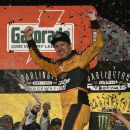5:02 am | September 5, 2018 | Go to Source | Author:
Barney Visser stood outside his hauler at Martinsville Speedway last October, and the question came up about how much of his own money had he put into Furniture Row Racing.
He gave one of those “I don’t know” looks and shook his head.
Visser probably knew but didn’t want to say, or didn’t want to think about it. He just seemed relieved he wouldn’t be sponsoring a car with his company’s money in 2018.
No one should be surprised by the news Tuesday that the organization, facing a 14-race sponsorship void in 2019, will not continue after this season. The more surprising part is that it made it all the way to 2018.
The 2017 NASCAR fairy tale of Furniture Row Racing has turned into a story that, despite Visser’s best efforts and tens of millions of dollars spent, shows the brutal reality of this sport: It costs millions to play in the sandbox, success for a newcomer is likely a product of being at the mercy of an alliance with a more powerful organization, and victories and championships are no guarantees of revenue nor sponsorship.
That wasn’t the story a year ago. The NASCAR industry couldn’t get enough of the Visser’s awesome journey to the 2017 NASCAR Cup championship, proving that a primarily single-car team (it was two cars for just one season, in 2017) could rise to the level of a Cup champion. Heck, you didn’t even have to be in North Carolina, as Denver, Colorado, was this team’s home.
Now it’s, “Oh my gosh, how can this happen?”, comparing Tuesday’s news to the Philadelphia Eagles shutting down a year after winning the Super Bowl.
How can it happen? Pretty damn easily. A sponsor says buh-bye — 5-Hour Energy opted to end its 14-race sponsorship after this season — and the dude who has acted like one of those GIFs of people throwing dollars away decides that it isn’t worth it anymore.
“NASCAR will continue to work on growing the sport and working with the race teams on competitive and operational excellence,” NASCAR said in a statement after the Furniture Row announcement. “Much of those efforts have already been put in place, and will continue to be a focus.”
Only people wearing the NASCAR-is-great sunglasses are trying to figure out how this happened. Everyone else knows exactly how this happened: Every team owner has a limit on the willingness to spend to vie for wins in a league with no revenue sharing, a frenzied free-agent process for both drivers and crew members, an inability to limit the skyrocketing costs to engineer cars that end up making the racing less competitive, and a ruthless quest for sponsorships that turn the nicest people into cutthroat artists.
Visser isn’t the only successful newcomer to NASCAR ownership levels in the past decade because he is brilliant or the creator of a secret sauce. It’s because he was able and willing to outspend what most would consider a reasonable business investment when trying to beat the goliath race teams.
A brief history lesson: Furniture Row was a team that struggled in the beginning — and for years. It had drivers such as Kenny Wallace and Joe Nemechek who couldn’t manage top-5s as the organization tried to do its own thing.
Regan Smith won at Darlington in May 2011 — the 137th race in which Furniture Row Racing competed in the Cup Series and the 46th as part of a technical alliance with Richard Childress Racing. Kurt Busch made the playoffs with the team in 2013 but didn’t win a race. Martin Truex Jr. won in the team’s 285th start in 2015.
This team competed in Cup for 10 years — part-time for three, full-time for seven — and won two races.
Who in their right mind is going to try to start a race team with those odds? And why would anyone keep going?
Visser continued, but in 2016 he started working as an alliance and technical partner of Joe Gibbs Racing and Toyota. That is when the team finally broke through as a race-winning contender week in and week out. Truex won four races in 2016, eight races and the championship in 2017 and has won four races this year.
The 2017 season was the only year the organization fielded two cars, with JGR helping fund driver Erik Jones.
As the founder of the Furniture Row stores and the Denver Mattress brands, Visser was relieved he wouldn’t have his companies sponsoring a car in 2018 when he cut back to one team. Instead of Furniture Row on the car, 5-Hour Energy would do 14 races and Bass Pro Shops would do 16, leaving just a handful of races that needed funding.
With Furniture Row stores absent from some NASCAR markets, it seemed like a waste of money to put his company on the car. Big-box retailers continue to find it challenging in this online-purchasing age.
Visser is no Roger Penske, who can get a Shell deal by agreeing to purchase hundreds of thousands of gallons of gasoline each year for his trucking businesses. He isn’t a Rick Hendrick, who can do a deal with Axalta automotive-paint finishes and have it work as a business-to-business relationship with his dealerships.
There was no way for Visser to leverage his team. He just wanted to race. He didn’t care too much about marketing, even — he kept some of his costs down by not spending for things such as a sign, the shop, a big corporate meeting room or a studio to create social content — because he wanted to spend his money on the parts and pieces to go fast. He won a championship.
He also had a heart attack along the way and, at 69, it appears he feels the best decision for him and his family is to cut back instead of trying to find a replacement for 5-Hour Energy.
Visser said he felt like he climbed “Mount Everest.”
The thing is, when you climb Mount Everest, do you really want to do it a second time? And would anyone want to spend more than a decade on the climb?
That’s what people should be asking themselves in light of the Furniture Row Racing news. It’s not how this happened. It’s how many more Barney Vissers there are out there, and if there aren’t, how this sport will survive.
Powered by WPeMatico



